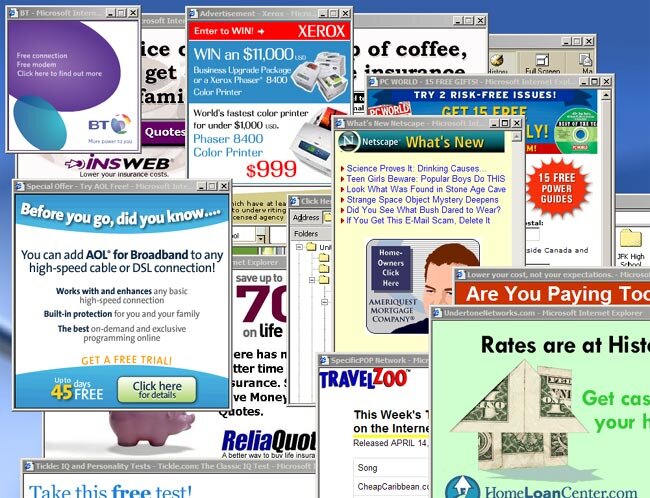From pop-up ads to behavioural capitalism: how invisible infrastructure has changed the way we consume
Rebecca Edwards
Pop-up advertisements first appeared in the late 90’s (1) on the free web-hosting site Tripod.com, a web-hosting service aimed at younger graduates and one of many sites at that time helping in the construction of online communities (2). Conceived as a solution to the problem of unsavoury and/or unrelated content appearing on client's websites, pop-ups enabled the client to have all the benefits of advertisement revenue, with less of the stigma of what those adverts might contain. In other words they removed or at least mitigated the client's responsibility from what the pop-ups might well be trying to sell or at least advertise directly to site visitors. Pop-ups also allowed for web traffic to be contained within the client website, which became increasingly more important to dot-com businesses and e-commerce with the implementation of SEO tools around the mid 90’s. By appearing in a separate browser window, pop-ups would no longer be read as entirely integral to the client website and as such it's reputation was no longer undermined. To this day pop-ups remain widely acknowledged as a nuisance to the 'internet experience', being something intrusive, clickbaiting and generally misleading (3). In the heyday of pop-up advertising it was common to encounter excessive amounts of pop-up content, at times rendering those websites as almost unreadable.
Image credit: Wiki Pics - http://sh.wikipedia.org/wiki/Datoteka:Pop-up_ads.jpg#/media/File:Pop-up_ads.jpg
Any study of the creation and development of the pop-up phenomenon must begin with Ethan Zuckerman, heading the Center for Civic Media at MIT and subsequently employed as a designer/programmer for Tripod.com. Although believing in the ethos of the early internet adopters, seeing it as a “global public square”, Zuckerman was nevertheless wary of creating sellable ads to fund Tripod’s free web-hosting service. Tripod had previously employed a number of revenue streams to keep it's business afloat, including (inter alia) selling merchandise directly, a subscription service and also a paid-for magazine, but the most lucrative income stream was unsurprisingly found in advertising. This ad-based business model still dominates the Internet today, which evolved alongside with how the Internet is currently used to utilise data and other analytics to provide more “targeted ads” - more on that soon. Today there are many more ad-based business models, all with varying levels of price, size, and scale. Currently the most widely used model is social media advertising which in 2018 surpassed the $100billion mark in the US alone (4). The prevalence of Internet advertising is something Zuckerman, and others, have described and defined as causing the death of the internet - in other words “the fallen state of our Internet is a direct if unintentional consequence of employing advertising as the default model to support online content and services.” (5) This default model of financial support for businesses across the internet has undoubtedly shaped the evolution of ecommerce and the inherent consumerist tendencies of populations grounded on capitalist economic policies.
In the early 1990’s targeted adverts were at best rudimentary in function - often based on broad assumptions of what a given audience might find appealing. Writing in Security for Software Engineers (2018), James N. Helfrich stated that as little as three years after the first pop-up advertisement was created all major web browsers included functionality to limit or eliminate pop-up ads entirely. The ads of this era were clumsy, pervasive and often unrelated to the needs of the consumer. Advertising directed at the public would need to become smarter, and less intrusive, to convert potential consumers into actual physical sales. In the early 2000’s companies took browsing habits, together with other related data, all collected from users via cookies, to attempt to personalise ads by interpreting these superficial data points. With this newfound proof of search history and consumer habits the ads were less about assumption and more about predicting and personalisation - this prediction providing estimates for object desirability, services and consumables for every site visitor and provided in a way which sought to reduce the consumer’s time spent searching for items or services (6). They were handed what they wanted on a silver platter, often before they even knew they wanted it.
Today, this type of insidious predictability within targeted ads is linked to what Shoshana Zuboff has termed ‘Surveillance Capitalism’. Put simply, surveillance capitalism is a new term founded on predictive algorithms in tandem with mathematical calculations monitoring or predicting human behaviour. In an interview with the Guardian last year, Zuboff stated that “surveillance capitalists sell certainty to business customers who would like to know with certainty what we do. Targeted adverts, yes, but businesses also want to know whether to sell us a mortgage or insurance, what to charge us, do we drive safely? They want to know the maximum they can extract from us in an exchange.” (7) This extraction and distillation of human interaction with online platforms - be it via mouse or keyboard clicks, textual exchanges or pattern recognition of browsing habits - is all shrouded in hyperbole and glossy imagery, and is an exchange with ramifications often only known by those who are privy to the underhanded algorithmic processes. The underhandedness within advertising culture oozes into the realm of propaganda and the ways that online media and advertising pioneers are now acting as a kind of incubator for psyops-style techniques for political campaigns, the obfuscation of news articles and videos, amongst many other things. Tactics used here are aimed at influencing emotions, reasoning, motives and behaviours, which are then weaponised by politicians and governments as a way of exerting control over their populations. The filter bubble is rife in these realms and has serious negative implications for civic discourse, and the ways governments and states function.
“The thing about predicting the future is that it always becomes a matter of controlling the future.” (8)
Photo illustration by The Daily Beast - https://www.thedailybeast.com/facebooks-algorithm-hijacked-this-dollar8-billion-company-to-sell-cat-blindfolds
Now that ads have become so entwined with digital content - through paid-for advertisements or recommendations posted by social influencers and lifestyle magazines - the way we purchase and consume is changing too (9). A report run by social media management platform Hootsuite in 2019 found that 130 million Instagram users tap on shopping posts every month (10) which are targeted at the platform’s 1 billion monthly users. Ranging from make-up and clothing, to cat blindfolds (11) sold by American e-commerce channel Wish, the report estimated that Instagram will earn $12.32 billion from ad revenue in 2020. When Instagram stories launched in 2016, companies were able to infiltrate another level of ‘scroll-time’; the video ads in stories often imitate the vernacular of popular influencers through colourways, shooting angles and editing techniques. In doing so, content and advertisements within social platforms begin to homogenise, lulling viewers into an autopilot state where consuming becomes the main purpose of their absentminded scrolling.
These shoppable ads are still a relatively new feature on Instagram but the traction they have gained shows a significant shift in the way we choose to purchase, or the ways in which we are made to purchase. Presenting advertisements to users in this way exacerbates the manner in which these social platforms are designed to keep us both hooked to the app, and within the app itself (similar to the way pop-up ads help to retain users on a website) - the new checkout feature on Instagram makes it possible to product purchase without ever leaving the Instagram interface. Although Instagram is certainly not the first to have enabled this - WeChat (12), Facebook Marketplace, and Depop have all operated in this way since 2011 or later.
How information is consumed today, either by images and video content or via digital platforms, is such that there is no time for us to stop and think about our actions, there is no design in place allowing us to question our behaviour. No curtain call, no blank space, no prompt for a change of pace or scenery. Social media applications, news sites, streaming services, email and messaging services are all bottomless sources allowing mindless scrolling, and it is within this scrolling, clicking and watching that we become trapped in a never ending loop of the architecture of capitalist monopolies.
In this landscape where cultural consumption has seamlessly converged with aspirational ideology, the pop-up presents a welcome disruptive potential. Clunky and often poorly designed and executed, the pop-up is the obnoxious ancestor of Surveillance Capitalism. What ultimately made the pop-up so repellant is that it created a break in immersion, causing the user to disconnect from the immediate interface of a website and thus detach from it’s content. The pop-up therefore is worth commemorating for the unruly power it possesses: although created to aid the flow of consumerism, it is perhaps better suited as a new stopping-cue tool, one to create blockages, disruptions and jarring breaks from the seamlessness of consumerism as we experience it today.
Banner ads however first appeared in 1994 on the online magazine Hot Wired:
P. 209, Naren Nath (2020). The consumer revolution : tipping the balance of power. Los Angeles: Sage Publications.
Ethan Zuckerman, the man responsible for coding the first pop-up, has apologised for the unforeseen nuisance that pop-ups have evolved into in an article for The Atlantic called the Internet’s Original Sin - https://www.theatlantic.com/technology/archive/2014/08/advertising-is-the-internets-original-sin/376041/
Of course, pop-up advertisements, and online advertisements in general, have since shifted to become more related to a user's typical online behaviours or interests in the form of ‘surveillance capitalism’ which will be discussed later in the text.
Graham, M. (2019). Digital ad revenue in the US surpassed $100 billion for the first time in 2018. [online] CNBC. Available at: https://www.cnbc.com/2019/05/07/digital-ad-revenue-in-the-us-topped-100-billion-for-the-first-time.html
Krishna, G. (2015). The Best Interface Is No Interface: The simple path to brilliant technology By Golden Krishna. P.54.
This predictive analysis is seen mostly across large ecommerce companies like Amazon and eBay, but is also used in healthcare to predict sickness of patients, on entertainment sites like Netflix, and in cybersecurity to detect fraud.
Zuboff goes on to write, “Surveillance capitalism unilaterally claims human experience as free raw material for translation into behavioural data. Although some of these data are applied to service improvement, the rest are declared as a proprietary behavioural surplus, fed into advanced manufacturing processes known as ‘machine intelligence’, and fabricated into prediction products that anticipate what you will do now, soon, and later. Finally, these prediction products are traded in a new kind of marketplace that I call behavioural futures markets. Surveillance capitalists have grown immensely wealthy from these trading operations, for many companies are willing to lay bets on our future behaviour.”
Naughton, J. (2019). “The goal is to automate us”: welcome to the age of surveillance capitalism. [online] the Guardian. Available at: https://www.theguardian.com/technology/2019/jan/20/shoshana-zuboff-age-of-surveillance-capitalism-google-facebook
321HAU (2020). James Bridle – Other Intelligences // Spy on Me #2 Online Programme. YouTube. Available at: https://www.youtube.com/watch?v=-S3rJnTxFoY [Accessed 6 Jul. 2020].
Advertising in the age of the pop-up was about interrupting you, jerking you out of whatever you were up to and wrenching your attention to the ad in the hope that you will buy what it offers. Whereas advertising now is about skipping the need for attention and operating beneath the level of our ability to notice it at all, advertising now almost needs to be invisible in order to be effective.
Hootsuite (2018). 24+ Instagram Statistics That Matter to Marketers in 2019. [online] Hootsuite Social Media Management. Available at: https://blog.hootsuite.com/instagram-statistics/
Image available here - 2oceansvibe.com. (2015). [online] Available at: https://media.2oceansvibe.com/wp-content/uploads/2017/12/Screen-Shot-2017-12-14-at-11.14.49-AM.jpg [Accessed 18 Jun. 2020].
WeChat is a Chinese messaging, social media and mobile payment app developed by Tencent. It was first released in 2011 and now has over 1 billion monthly active users.
Rebecca Edwards is the curator at arebyte Gallery.


